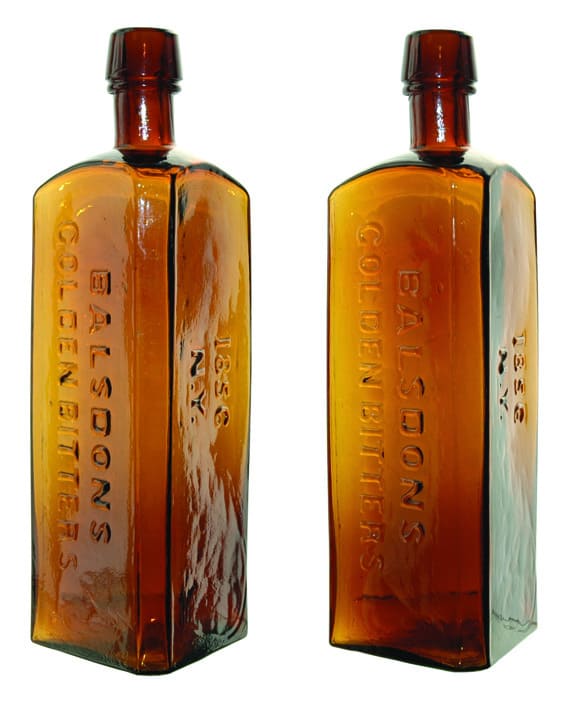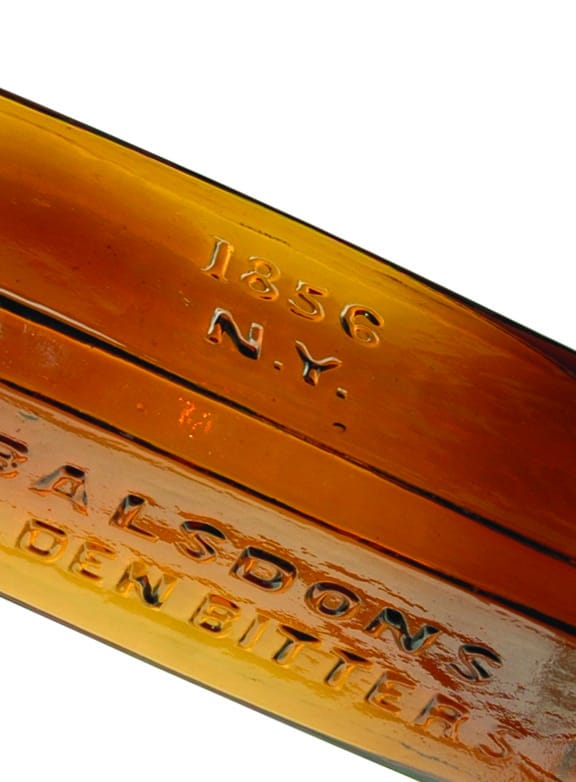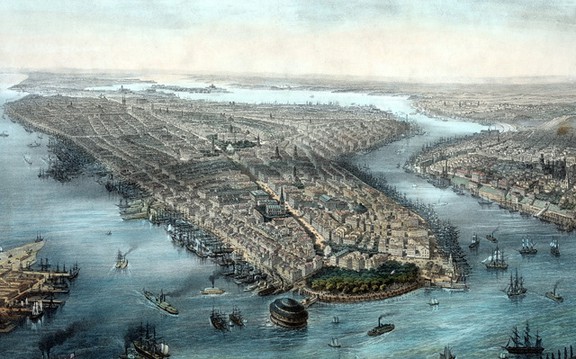The triangular Balsdons Golden Bitters – Early New York
15 January 2012
![]() My next installment for triangular bitters is the extremely rare Balsdons Golden Bitters. My highly whittled example has a bold impression and was purchased in February 2006 from Glass Works Auction 76. Glass Works noted that the bottle was the first example that they had seen in 20 years. Please see the “Digging a Good Bitters Bottle” article by Gary Guest below. I believe that my bottle was found in the Brooklyn dig.
My next installment for triangular bitters is the extremely rare Balsdons Golden Bitters. My highly whittled example has a bold impression and was purchased in February 2006 from Glass Works Auction 76. Glass Works noted that the bottle was the first example that they had seen in 20 years. Please see the “Digging a Good Bitters Bottle” article by Gary Guest below. I believe that my bottle was found in the Brooklyn dig.
The Carlyn Ring and W.C. Ham listing in Bitters Bottles is as follows:
B 15 BALSDONS GOLDEN BITTERS, Circa 1860 – 1870
BALSDONS / GOLDEN BITTERS // 1856 / N.Y, // sp //
E. Balsdon 17 Cedar Street New York City
9 3/4 x 3 5/8 (7 1/2) 1/2
3-sided, Amber, LTCR, Applied mouth, Extremely rare
Digging a Good Bitters Bottle
by Gary Guest
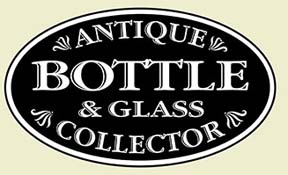 (as reprinted from Antique Bottle and Glass Collector Magazine many years ago when run by Jim Hagenbugh and Glass Works Auctions)
(as reprinted from Antique Bottle and Glass Collector Magazine many years ago when run by Jim Hagenbugh and Glass Works Auctions)
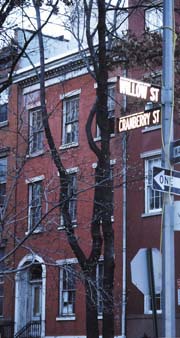 1820, that’s the date that was on our minds, as we circled Willow Street looking for a parking spot. True, we’d dug earlier pits, but this one was the first in which the house was still standing, right down to its Federalist style interior and 12-inch plank floors, it was 1820’s all the way. After a short week away from the Brooklyn Heights neighborhood, we were back, ready to dig once again, in the section of the city known as America’s first suburb. In this case, the city that just happened to give birth to that section of Brooklyn happened to be located on nearby Manhattan Island.
1820, that’s the date that was on our minds, as we circled Willow Street looking for a parking spot. True, we’d dug earlier pits, but this one was the first in which the house was still standing, right down to its Federalist style interior and 12-inch plank floors, it was 1820’s all the way. After a short week away from the Brooklyn Heights neighborhood, we were back, ready to dig once again, in the section of the city known as America’s first suburb. In this case, the city that just happened to give birth to that section of Brooklyn happened to be located on nearby Manhattan Island.
Just across the East River lay the New York skyline, an impressive array of skyscrapers and waterfront landscapes, that today, resemble nothing of the New York of the early nineteenth century. Back then the population of the city was mainly concentrated in lower Manhattan below Fourteenth street; there were no buildings higher than a few stories, and no bridges connecting Brooklyn to neighboring Manhattan. For those who chose to live in Brooklyn Heights and work in New York the daily commute meant using one of three different ferries, that were constantly braking down, running late, and at the mercy of the local weather, when they ran at all (for those who commute to work by public transportation, it sounds familiar, doesn’t it?). Add to the mix, the congestion of lower Manhattan at the time and the grind of the commute, and it’s no wonder the serenity of the quiet tree lined streets of Brooklyn Heights, remained an attractive lure for settlement, for those who could afford to live there.
Affectionately known to most in the neighborhood as simply “the Heights”, the area is situated on bluffs that rise steeply above New York Bay and the East River. Aside from the addition of the Brooklyn-Queens Expressway, whose completion in the 1950’s, cut off the southwest and northwest corners of the neighborhood, most of the area has retained it’s nineteenth century charm. Of the approximately 1,100 homes there, more than 600 were built before the Civil War, with a good many dating back to the 1820-1840 period.
While Rich and I continued, passing street after street, looking for that elusive parking spot, I couldn’t help but wonder how little the rows of lovely brick and brownstone homes have changed in the last one hundred-fifty years. The occasional cobblestone street and coal chute outside many of the houses only add to the picturesque setting of many of the nineteenth century alley-ways and carriage houses that still dot the neighborhood.
The daydreams of a hopeless bottle romantic and history buff – you bet! With a quick reality check in the form of a sudden place to park the “diggin-mobile” it was time to unload everything, and dig a pit. As has been the case of late, Mitch also took his truck in, and along with Jack and Eric, managed to get there a little ahead of Rich and I.
Once we meandered through the house with what we’d figured would come in handy for digging, it was out the back door, to see what the guys were up to. We kind of knew that the backyard was pretty well kept, with a brick patio covering three-quarters of the property, ground tarps were definitely in order. Luckily, the pit was exactly where we’d figured it would be, and away from anything the homeowner didn’t want disturbed.
Within a short time the configurations of a rather small rectangular stone-liner began to take shape. Although there were a lot of old bricks in the top five feet of the pit, there didn’t seem to be anything else in the way of being able to dig this one rather quickly. The dirt was easy to move and seemed typical of the type we’d been encountering lately – real airy with lots of rust colored and gray ash.
The first bottles of any consequence were two black glass ale types, one pontil, the other smooth based, and probably English. From the beginning there were lots of shards of glass and stoneware, so much so, that we figured it best to start using the sifter. Early finds that might have otherwise gone unnoticed included, an 1810 large cent, a tiny “swirl” marble, and several unglazed “Pipe-clay” white marbles.
Although there was no guarantee as to what else we’d find, at least there was stuff turning up early on. Granted, the bottles weren’t anything special, but at least they were whole and kept our spirits high for what remained. Judging from several of the hinge mold medicines that were also showing up, I’d say we were into an 1860’s layer – whatever else lay beneath our feet was anybody’s guess. A nearly complete Ironstone chamber pot, that caught the eye of the homeowner, was another early find. Needless to say, we offered it up as a partial payback for giving us permission to dig.
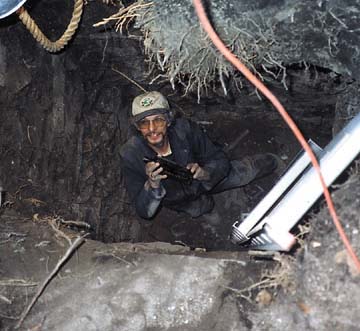 That’s me standing on the bottom of our rectangular stone-liner holding the best bottle of the day – the Balsdon’s Golden Bitters. A nicer lady you couldn’t find. I mean, when your served coffee and cake in between pulling and dumping buckets of dirt – hey, what can I say! I know that might sound a bit unusual, but we’ve come to expect the unexpected. You name it, from offers to pay parking and or towing expenses to being fed a full-course seafood dinner; Brooklyn people are truly amazing. So don’t believe everything you see on the evening news, all the people who live in the city aren’t all that bad.
That’s me standing on the bottom of our rectangular stone-liner holding the best bottle of the day – the Balsdon’s Golden Bitters. A nicer lady you couldn’t find. I mean, when your served coffee and cake in between pulling and dumping buckets of dirt – hey, what can I say! I know that might sound a bit unusual, but we’ve come to expect the unexpected. You name it, from offers to pay parking and or towing expenses to being fed a full-course seafood dinner; Brooklyn people are truly amazing. So don’t believe everything you see on the evening news, all the people who live in the city aren’t all that bad.
Even with ideal digging conditions, the bottle pile was definitely lacking. Aside from an occasional puff and a Stafford’s Olive Tar, that was pontiled, nothing much else was showing up. At the point we would have gladly swapped the nice weather and easy digging for a more difficult pit with more bottles.
The story was the same no matter who was working below. Each guy’s stint in the pit wasn’t producing much. Although the pile of mismatched pottery and glass pieces was impressive, and included a decorated water cooler, fancy tableware, and an 1870 Indian Head penny, there wasn’t a whole lot to cheer about. Little by little the privy was being emptied, and with it, the hope of uncovering anything out of the ordinary was becoming a real possibility. So much for the bottle visions of digging stuff that dated from the opening years of the nineteenth century!
Being the dirt also contained lots of ash, it was hard to keep even the smallest of shelves from collapsing, once any sizeable shards of glass or pockets of debris were moved around or disturbed. Even the slightest pass of the hand rake was enough to dislodge anything that was even partially visible. It was now early afternoon, so we figured whatever was left to dig wasn’t far away.
By now we’d all had at least one time in the pit with mixed results. Earlier in the day Eric had sent up some common type utility medicines; Mitch some bulbous looking food bottles, Jackie an iron pontiled whiskey from Manhattan, and Rich and myself, some tiny perfumes, and an ink or two. Not a lot of bottles when you consider the amount of dirt we had already moved. Down about ten foot now, the hope was something out of the ordinary.
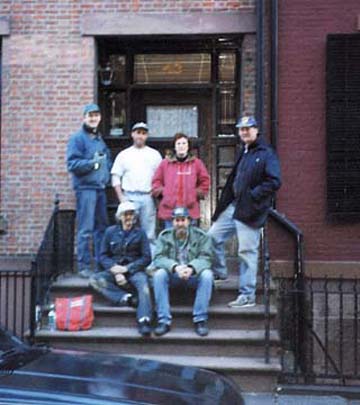 A parting shot of us with the homeowner for the digging scrap book. Finishing up our third book now, we always try to get a group photo, and include the people who give us permission to dig. Like I said before, without them we’d be out of business!
A parting shot of us with the homeowner for the digging scrap book. Finishing up our third book now, we always try to get a group photo, and include the people who give us permission to dig. Like I said before, without them we’d be out of business!
My last try at salvaging something decent near the bottom didn’t start out any better than before. Unfortunately, the pit had been cleaned out pretty good, with the oldest bottles reduced to nothing more than an occasional smidgen of glass, with no other pieces anywhere in the pit.
While doing some scraping in one of the corners, the rake hit what every privy digger fears the most – the bottom of the pit! A few quick shovels full across the dreaded area of concern confirmed what we didn’t want to hear. No doubt about it, the bottom was definitely in sight. At that point even if we had hundreds of bottles instead of the twenty of so we did have, the certainty of finishing up within a short time wasn’t something we were looking forward to.
Clearing half the pit to the bottom, there was no longer any need to take any more dirt out. What remained could just as easily be moved to the cleared side once I was sure it contained nothing. With the guys up top no longer having to do any more pulling or dumping, all eyes were on the last quarter of what was left to dig.
While breaking down what was left up against the remaining wall, a large triangular bottle fell towards the hand rake. Almost immediately I could see there was some type of embossing on one of the sides, and that it was amber.
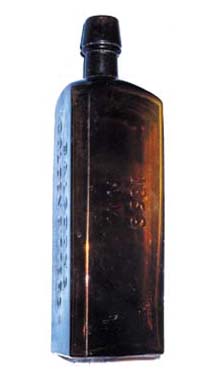 A quick glance revealed even more embossing on a second side – I couldn’t imagine what it could be. Stopping just long enough to read both sides, I was surprised when the mystery bottle turned out to be a Balsdons Golden Bitters, from New York, with an 1856 date on it.
A quick glance revealed even more embossing on a second side – I couldn’t imagine what it could be. Stopping just long enough to read both sides, I was surprised when the mystery bottle turned out to be a Balsdons Golden Bitters, from New York, with an 1856 date on it.
Although none of us are too knowledgeable when it comes to Bitters bottles, I think we knew it wasn’t a common bottle simply based on its shape. As things turned out, that was our last hurrah; what dirt remained didn’t contain anything else.
The final results of our efforts. Only about half the bottles were pontiled, and the presence of the 1870 penny confirms the pit was being used as late as the 1870’s.
Besides the Bitters, the picks were definitely going to be slim. All totaled, only about twenty bottles, two pipes, a broken yelloware plate, and two corroded pennies, certainly not the “glory hole” we envisioned.
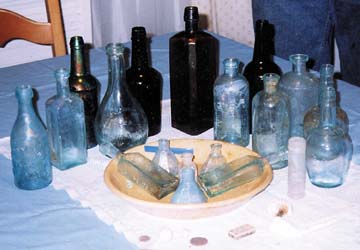 Oh well, until someone comes up with a way to know what’s buried beneath the ground before any digging begins, I guess there’s no other way around putting in a full day’s work to find out…
Oh well, until someone comes up with a way to know what’s buried beneath the ground before any digging begins, I guess there’s no other way around putting in a full day’s work to find out…
Our next scheduled dig is another permission we had gotten at an outdoor street fair last fall. On another old street, this time in the Cobble Hill section of Brooklyn, the house dates back to the late 1830’s. Should be a good start to the year 2000.
The guys had done some “advance scouting” of the backyard, and don’t foresee any problems. With any early entry come next Saturday, I guess it’s another week of wondering what the pit will contain…..
Read Further: The beautiful and triangular S (star) C Brown’s Herb Bitters
Read Further: Sanitarium Bitters & Hi Hi Bitters – No doubt what you are getting here!
Read Further: The triangular Hagan’s Dyspepsia Bitters – Atlantic City, New Jersey
Read Further: The Triangular O.H.P. Rose’s Peruvian King Bitters
Read Further: The extremely rare, triangular Wahoo Chamomile Bitters


